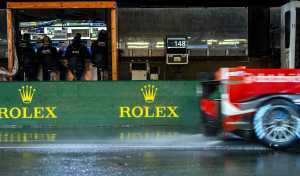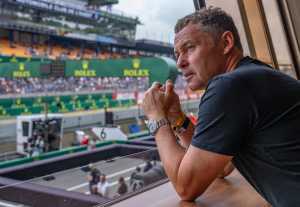Few names in motorsport command the reverence and respect that does. Known simply as ‘Mr Le Mans’, the Danish racing icon holds a record that may never be broken – nine overall victories at the 24 Hours of Le Mans, the world’s most gruelling endurance race.
Over a career spanning more than two decades, Kristensen became the gold standard for performance, precision, and perseverance behind the wheel.
From his debut win at Le Mans in 1997 to his final triumph in 2013, Kristensen not only dominated on the track but also helped shape the legacy of modern endurance racing. It’s little wonder he was approached by Rolex to become one of the watch brand’s acclaimed Testimonees.
Beyond the trophies and accolades, he is known for his thoughtful approach to racing, his calm under pressure, and his deep respect for the sport’s history and evolution.
But what do you ask motor racing royalty if you get the chance? For many of us enthusiasts, the mind immediately wanders to the origins of a racer’s speed: is it an innate gift or is it a learned skill? If you ask Kristensen, the answer is almost too simple.
“I’m fast… I’ve always been fast,” he tells me with a half chuckle. If anything, however, the Dane is being too modest.
Speed is one thing, but what about being fast for four hours straight, racing in darkness in the middle of the night with nothing but your wits to keep your wheels on the road? Or how about terrifyingly low visibility driving at an average speed of 220kph? That’s another thing entirely.
We sit down with Kristensen to reflect on the career of endurance motorsport’s most celebrated champion and explore the mindset that powered him to a record number of victories at 24 Hours of Le Mans.
Stephan Cooper
Square Mile: What is so special about the 24 Hours of Le Mans compared to other endurance races?
Tom Kristensen: I think it’s the history – the persistence of this racing discipline for more than a hundred years. You immediately feel that heritage when you are getting close to the city or even if you are in France, you know you are close to such an iconic event.
Around the world, the 24 Hours of Le Mans is known as one of the most important motor races. Of course, that also gets to the engineers, the mechanics, the fans, and certainly also to the drivers. The fact that it only happens once a year, it’s always there in the middle of June, that makes it really quite special.
Then you have the fact it’s 24 hours, which compared to some of the other endurance races that are six hours, eight hours or 12 hours of racing, it makes Le Mans a special task – making sure that you can do 220kph+ average speed over 24 hours, and that’s including driver changes and pit stops which will be in the region of 30 minutes of lost time.
Everyone wants to do their utmost, everyone wants to do themselves proud, it’s unlike anything else.
SM: Do you remember the first time you encountered speed, the rush of adrenaline that you get while driving a car?
TK: It’s always a part of me. The very first time I believe I felt that way was in a very low car in the passenger seat with my father. My father was a racing driver and I think he gave it a little bit of power through this forest dirt track, so I can see the trees blur, and that kick is something that I’ll never forget.
But, for myself, I also remember the first time I was sitting in a go-kart just a few centimetres above the racing surface. I was about eight years old driving the kart, that adrenaline and that fascination with speed for sure is still in me today. That drive to go fast is something you simply never forget or will ever lose.
Sébastien Agnetti
SM: How does your perception of time change in a race like 24 Hours of Le Mans?
TK: Time goes fast but you simply live in the moment and your focus is always on what’s immediately next. But there’s much more to it than the race itself. The preparation, the testing, all the things leading up to the race, that can be quite a strain to take it all in.
You come of course with belief, but preparation is key. So you’re already very focused on all of the things you need to have in place with your team, the complexities of managing the car over the race duration. But when the race starts, everything is simpler.
I would say you can separate the race itself into three blocks. The first block is making sure you get well into the race, applying pressure going into the evening when you have the sun, that’s the first challenge.
Once you pass the sunset, then you’ll go into block two, which is long and you know you need to be extra sensitive during the night. I would say that block three starts after dawn. When you pass that point then it’s the long push to the finish.
But, to answer the question on your perception of time, you are focused on the moment, what you are doing, getting into the zone, looking for the rhythm – your next gear change, your next braking point, your next corner, your next acceleration.
I have a feeling you don’t blink when you’re driving. When you’re in the lead it goes a little slower, but in general time flies.
Stephan Cooper
SM: One of the most curious things about the 24 Hours of Le Mans is that you drive for a maximum of four-hour stints. How do you train yourself to drive for so long?
TK: I have done it for many years now, so it’s second nature for me. But, of course, when you go into the race for the first time, you are all about making sure that you don’t make a mistake.
In my last races it was all about living up to not disappoint. In that sense, it’s really important that you have a very, very strong mental desire to go through, because generally you will have a lot of sacrifice to prepare yourself for the event.
You need to be fit and you need to have that trust in yourself and that belief you can make it, you can win.
That’s why you need to ensure all these fundamentals are in place: you need to be fast, you need to be consistent, you need to be in good shape and you need to be a little bit more disciplined around your food. In fact, around the weekend you need to be disciplined all the time.
During the week and the lead up to the weekend at Le Mans you need to be extremely careful that you get enough electrolytes because in the hot years, we could experience up to 60 degrees Celsius in the cars.
The demands of racing require you to be fuelled with all the right things all the time because cramp is your worst enemy in a car. You want to do everyone proud, your team, your mechanics, you don’t want the reason why you failed to be something so easy.
It’s always the small things. It’s just, “Oh I just hit the curb a little bit too much” or something like this and – poof – you are off the racetrack and you don’t win Le Mans. The mental aspect, the unrelenting focus, is crucial. There are no shortcuts.

SM: I’m interested in your partnership with Rolex. How did it come about?
TK: Rolex was already associated with Le Mans when I first raced here, but nevertheless my time in racing, my time in sports cars and my time in Le Mans has evolved in parallel with that partnership.
Every once in a while, some of the Rolex team would invite me to have just simply friendly conversations around Le Mans.
When I had a few more victories at Le Mans, and I was getting close to the record number of wins, Rolex approached me and said they would love for me to be a Testimonee in the future.
It took a few more years because they wanted to respect the arrangement I had with a watch company from Denmark first, but I’ve now been with Rolex since 2010.
You could say it was already in the pipeline with this nice relationship we had, but for me it was an achievement in itself of having, for me, the greatest watch brand already supporting motorsport for so many years approaching me to be a Testimonee.
SM: Do you have a particular Rolex watch that is the most meaningful to you?
TK: My first victory at Le Mans happened so fast in 1997 with Joest Racing, but I had a few hard hits of not winning before 2000 came around.
I had long decided that if I finally won Le Mans again I was going to mark the moment with a Rolex Daytona, so after that second victory in 2000 I did just that.
I bought myself a Daytona with a black dial and I had the caseback engraved. That was my first Rolex watch of many, and it represents not just that victory but my first achievement with Audi, which at the end of the day became the car manufacturer with whom I had most of my victories.
For that reason that watch is very important to me.

Stuart Wallace
SM: What has made you such a racing tour de force? Is it nature or nurture?
TK: Oh, I’m fast. I’m fast, I’m determined and I always want to go a little bit faster than the previous lap and then I don’t want to overdo it because I also want to be consistent. In that sense I’ve always been fast, but I think maybe you will know that.
I’ve always had that passion for speed from the very first metres in that kart. I did karting and open-wheel races, but it took me a long time before I was professional.
In 1991, I signed on to do the German F3 championship with Bertram Schäfer Racing and I won the first race there and since then it sort of materialised around the world – living five years in Japan and so forth.
But the big breakthrough after winning races in all categories I have been in was when I won Le Mans in 1997. It’s true that I have only done Formula One testing, but that helped me focus more on being the best or try to be the best in endurance and winning the most titles in that way.
The biggest setback I’ve had in my career was when my BMW team was leading Le Mans in 1999. It was JJ Lehto, Jorg Muller and myself.
We were nearly four laps in the lead and then a small thing happened with a damper and we retired. That’s the biggest disappointment in my professional life.
Thank God, I won the year after and then went on to win the next six races in a row with four different teams.
I was with the Audi Sport Team Joest for three years, then Team Bentley in England, then the Audi Sport Japan Team Goh, and the American ADT Champion Racing to break Jacky Ickx’s 24 Hours of Le Mans record.
I would say the journey to good achievements is sometimes you learn from your setbacks and I would say the sacrifice you go through or sometimes just surviving a crushing defeat like in 1999 and then coming back stronger, that’s really important. Losing in 1999 was a huge moment in my career for that reason.
Adam Warner
SM: If you could take me back to your first victory at Le Mans, what were the specific challenges you have to overcome?
TK: It was my first Le Mans, so I wanted to take the chance, grab it by the horns, and of course I was the young one with Michele Alboreto and Stefan Johansson, two fantastic drivers who have already shown their capabilities in Formula One as well.
In that sense, I believe everyone thought of me as a weak link, but particularly Michele saw it different. He was very good at trying to give me confidence, and say, “Hey, we need you Tom, you are the guy who’ll be driving most at night because you are young, you will have better eyesight, the way you drove in Japan. Everything is going well for you there. We are really happy that you are part of the team.” He gave me the confidence you need to have as a driver because when you’re in the car and you start to doubt, you make mistakes because you are pushing the limit.
You need to be absolutely in sync with what you think you can do and you have to feel good about that. And I would say Michele was a key player in my first time and, it’s funny, I never met him before the first time I sat in the car at Le Mans in 1997 as I was only signed up to join them just a few days before that. I only got 17 timed laps before the start of the race.
There was no data, there was hardly any mobile phones at that time. They were just being introduced but there was no simulator. It was a bit more word of mouth in terms of how you explain the circuit, which gear you go in the different corners.
You have to remember as well, the track is 13.6km long. It’s triple the size of a Formula One circuit and at the time there were no floodlights. Some of it is floodlit now, but back then there was no floodlight or stadium light.
It was dark more or less everywhere apart from the start-finish line and up through the Dunlop Chicane.

Stephan Cooper
The first time was very different, but I’ll never forget my night stints. I probably didn’t impress too many, but I didn’t make mistakes.
I was, of course, spending so much energy trying to do a good job, but I started to find the rhythm and they give me feedback over the radio, “Hey Tom, you are doing well.”
And then I took the fastest lap which really energised me. At that moment the dawn is happening and I’m getting out of the night and I can see more and more.
Then I get a lap without any traffic, which I haven’t had many of in my entire career at Le Mans, and they scream at me “Lap record, lap record, keep it steady now!”
When a German starts to speak with you in English, it means that hey, things are going well, we are getting eye to eye.
That was a key moment probably for my Le Mans career because I could have crashed during the night. So many times you are going through seven to 11 cars per lap of the other categories and you just have to pass them as fast as possible.
Every time you have to lift or brake a little bit early into corners of the slower category cars you are constantly playing with the risks.
At the end of the day, we won the race. We were fighting to get up to the leaders at that time, but I could just have been taking it easy, being slow, then we wouldn’t have won. And, you know what? You wouldn’t have been talking to me today.

Jad Sherif
Tom Kristensen is a Rolex Testimonee. Discover more at rolex.com
